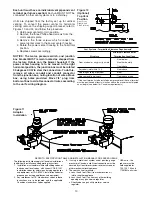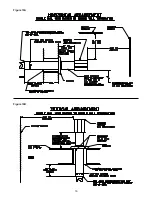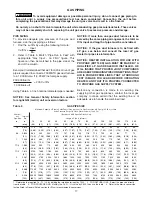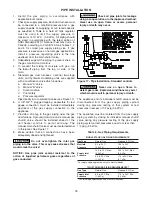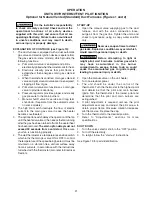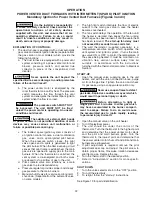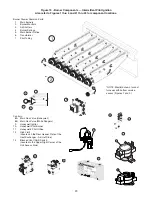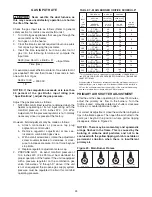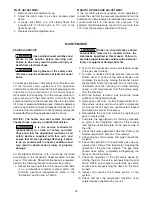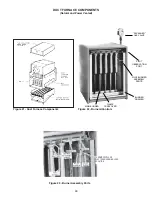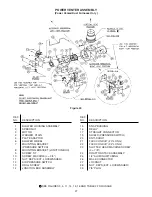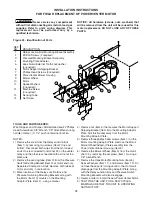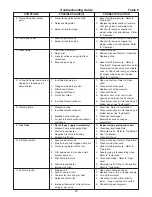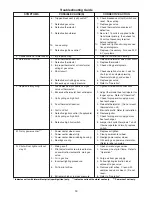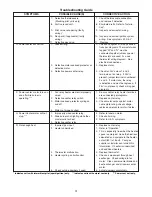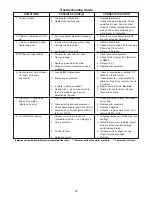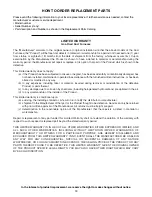
25
PILOT ADJUSTMENT
1.
Remove the pilot adjustment cap.
2.
Adjust the pilot screw to provide a properly sized
flame.
3.
A proper pilot flame is a soft steady flame that
envelops 3/8 to 1/2-inch (9.5 to 12.7 mm) of the
flame sensor tip.
4.
Replace the pilot adjustment cap.
MANIFOLD PRESSURE ADJUSTMENT
If the manifold pressure requires minor adjustment,
remove the cap from the pressure regulator and turn the
adjustment screw clockwise to increase the pressure, or
counterclockwise to decrease the pressure. The
adjusted manifold pressure should not vary more than
10% from the pressures specified in Table 6.
Under no circumstances should
combustible material be located within the
clearances specified in this manual. Failure to
provide proper clearance could result in personal
injury or equipment damage from fire.
2. Turn off the manual gas valve and electrical power
to the gas duct furnace.
3. To clean or replace the main burners, remove the
bottom panel or slide out the pullout drawer, and
compress the spring by moving the burner toward
the manifold. Slide the opposite end of the burner
downward from the locating slot while retaining
spring is still compressed. Pull the burners away
from the manifold.
4. With the burners removed, wire brush the inside
surfaces of the heat exchanger.
5. Remove any dirt, dust, or other foreign matter from
the burners using a wire brush and/or compressed
air. Ensure that all parts are unobstructed. Inspect
and clean pilot burner if necessary.
6. Reassemble the gas duct furnace by replacing all
parts in reverse order.
7. Complete the appropriate unit start-up procedure
as given in the “Operation” section of this manual
(see lighting instruction plate on the access side of
the unit).
8. Check the burner adjustment. See the “Primary Air
Shutter Adjustment” section of this manual.
9. Check all gas control valves and pipe connections
for leaks.
10. Check the operation of the automatic gas valve by
lowering the setting of the thermostat, stopping the
operation of the gas duct furnace. The gas valve
should close tightly, completely extinguishing the
flame on the main burners.
11. Check the operation of the pilot safety device by
closing the pilot line valve, extinguishing the pilot
flame. Within one minute the automatic gas valve
should close, extinguishing the flame on the main
burners.
12. Inspect and service the blower section of the
system.
13. Check and test the operational functions of all
safety devices supplied with your unit.
PERIODIC SERVICE
Open all disconnect switches and
secure in that position before servicing unit.
Failure to do so may result in personal injury or
death from electrical shock.
Gas tightness of the safety shut-
off valves must be checked on at least an annual
basis.
To check gas tightness of the safety shut-off valves, turn
off the manual valve upstream of the appliance
combination control. Remove the 1/8 inch pipe plug on the
inlet side of the combination control and connect a
manometer to that tapping. Turn the manual valve on to
apply pressure to the combination control. Note the
pressure reading on the manometer, then turn the valve
off. A loss of pressure indicates a leak. If a leak is detected,
use a soap solution to check all threaded connections. If
no leak is found, combination control is faulty and must be
replaced before putting appliance back in service.
NOTICE: The heater and vent system should be
checked once a year by a qualified technician.
It is the service technician’s
responsibility to check all safety controls!
Check and test the operational functions of all
safety devices supplied with this unit, and
ensure that all are operating effectively. Failure
to do so could result in unsafe conditions and
may result in death, serious injury or property
damage.
All Maintenance/Service info should be recorded
accordingly on the Inspection Sheet provided on back
cover of this manual. Should maintenance be required,
perform the following inspection and service routine:
1. Inspect the area near the unit to be sure that there
is no combustible material located within the
minimum clearance requirements listed in the
“Installation” section and in Table 4.
MAINTENANCE
Summary of Contents for NATURAL INDOOR GAS-FIRED DUCT FURNACE
Page 14: ...14 Figure 12A Figure 12B...
Page 15: ...15 Figure 13A Figure 13B...
Page 34: ...34 NOTES...
Page 36: ......



